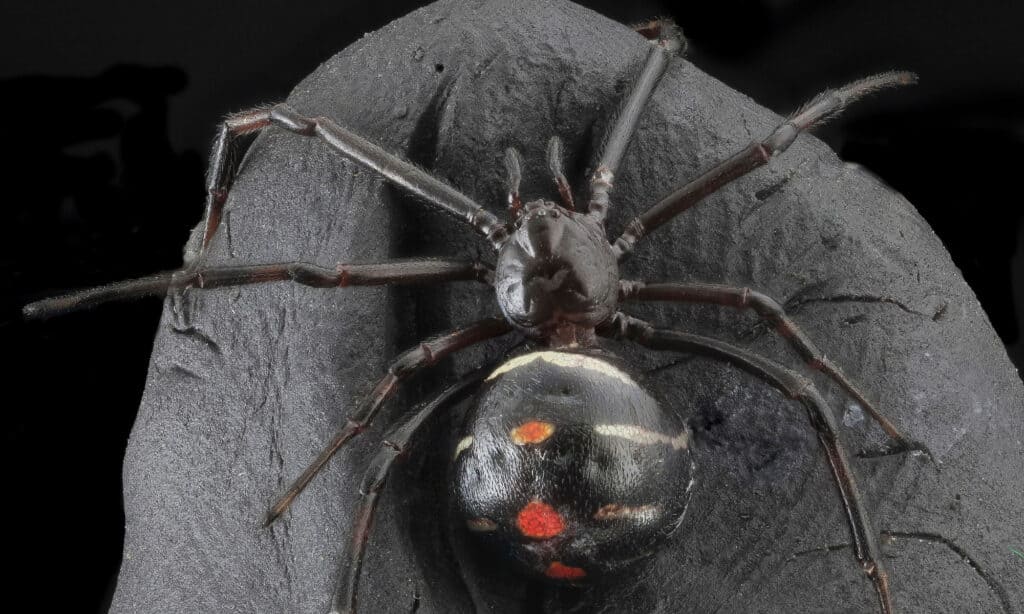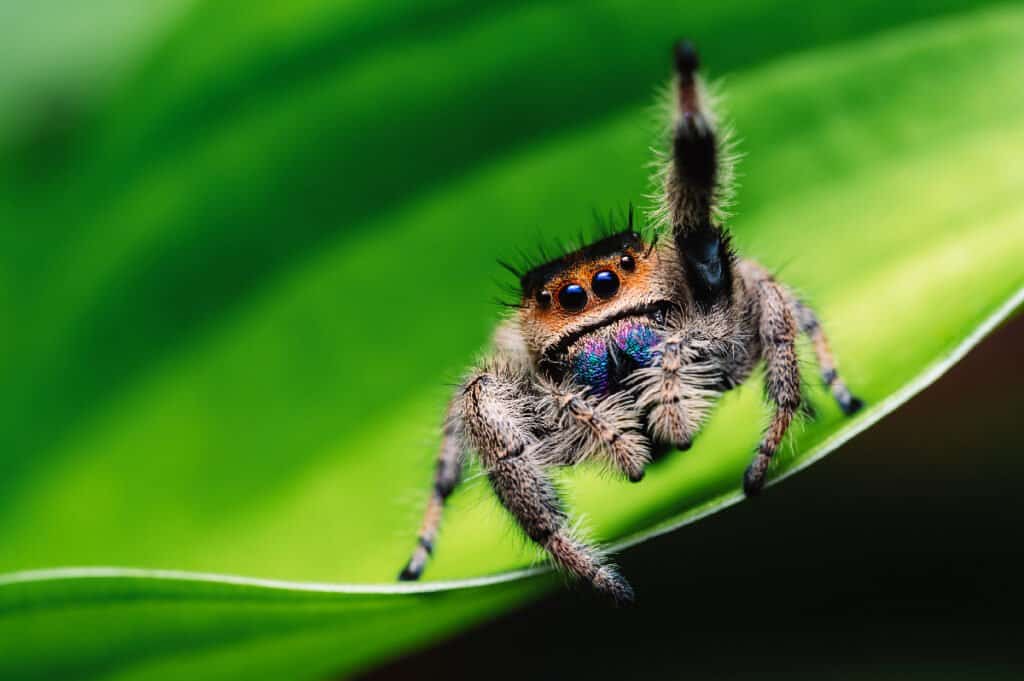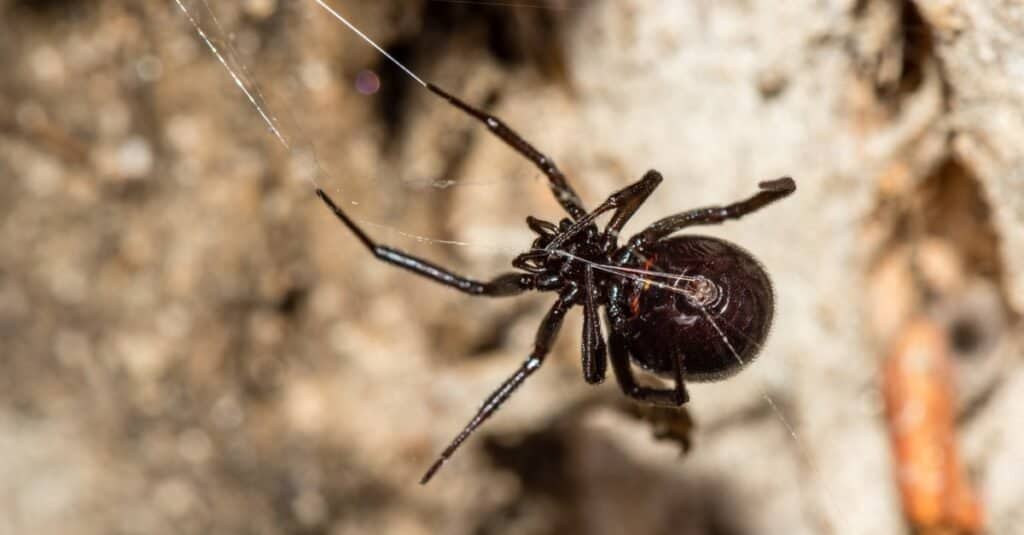
Many species of black spiders call Kentucky home; some of them are dangerous, like the black widow, while some are completely harmless, like jumpers.
Getting to know the spiders in your area can come in handy, whether you’re curious about a species in your garden or worried about a potential problem. Here’s a closer look at eight different types of these fascinating arachnids.
1. Northern Black Widow (Latrodectus Variolus)

The upper side of their abdomen is glossy black and bears a distinctive red orange “split” or broken hourglass shape on the underside.
©Porco_Rosso/Shutterstock.com
Of course, you can’t talk about black spiders without mentioning the black widow. Like other members of the genus Latrodectus, it has venom that is considered medically significant, though most bites are not fatal.
Adult northern black widow spiders typically measure 1/2 to 5/8 inch in length. The upper side of their abdomen is glossy black and bears a distinctive red orange “split” or broken hourglass shape on the underside. Males are smaller than females and may have additional yellow or white markings and longer legs.
These spiders are found in the eastern United States, from southern Canada to Florida. They live in various habitats, from suburban backyards to fields and forests.
They feed primarily on insects, though they have been known to eat small vertebrates such as mice and lizards in some cases!
Northern black widows are primarily nocturnal and solitary, only coming together to mate. They are generally timid spiders and will retreat into their webs if disturbed. So, even if you come across one, this spider is more likely to back away from you than attack outright!
Fun Fact: Females eat their mates after copulation. This is where these spiders get their name.
2. Emerald Jumping Spider (Paraphidippus aurantius)

The emerald jumping spider is typically brownish black, with bright emerald-green highlights on its body and legs.
©iStock.com/Jan Rozehnal
The emerald jumping spider is a species found in the United States. They get their name from their distinctive emerald, green coloring.
The emerald jumping spider is typically brownish black, with bright emerald-green highlights on its body and legs. It has two large dark eyes and four small eyes on its head. The spider is about 1/4 of an inch in size, with a large abdomen and short legs.
This spider is commonly found in fields, gardens, and forests throughout Kentucky. They prefer to stay in shady areas away from direct sunlight.
It feeds primarily on insects and other small arthropods. Using its strong, fast-moving legs, it pounces on its prey before killing it with venom injected through its fangs. When not hunting, it likes to stay in its web or hide in crevices and other small spaces.
The emerald jumping spider is one of the few jumping spider species that can change color! It can shift from emerald, green to brownish-black and back again, depending on light exposure. This adaptation helps the spider blend in with its environment and avoid predators!
Fun Fact: This spider is an active, energetic hunter. It moves quickly, jumping long distances to catch prey.
3. Southern Black Widow (Latrodectus mactans)

Despite their notorious reputation, southern black widows are not aggressive and will only bite humans if they feel threatened.
©Jeff W. Jarrett/Shutterstock.com
Kentucky is home to not just one, but two distinct species of black widow spiders! Though they are similar to one another, the southern black widow is probably better-known than the northern black widow. These spiders grow up to 1.5 inches long. Like their northern counterparts, they have a glossy black body with a bright red hourglass-shaped marking on the underside of their abdomens.
Southern black widows live in all regions of Kentucky, but they are more commonly found in rural areas near woodpiles and sheds. They build web structures in corners and crevices, often hiding in dark places during the day. These spiders are nocturnal and come out at night to hunt for insects. This spider primarily eats small insects, including flies, roaches, grasshoppers, and moths. They also eat other tiny spiders.
Despite their notorious reputation, southern black widows are not aggressive and will only bite humans if they feel threatened. If you do get bitten, get medical help immediately.
Fun Fact: Female southern black widow spiders can lay up to 400 eggs at a time!
4. Daring Jumping Spider (Phidippus audax)

The daring jumping spider is a favorite among spider fans due to its vibrant colors and unique jumping ability.
©Mircea Costina/Shutterstock.com
This petite spider is a favorite among spider fans due to its vibrant colors and unique jumping ability. You can usually find the daring jumping spider clinging to walls and other stationary objects. It is a tiny arachnid measuring about ¼ of an inch in length. This spider has a black body with distinctive white and yellow to orange markings on its back.
This species is an active hunter, meaning it will move around to find its prey rather than building a web and waiting for a catch. The daring jumping spider uses its two big front eyes to spot potential prey and then quickly pounces on it. It jumps in a zig-zag motion, which makes it hard for its prey to escape.
Its diet consists mainly of small insects like flies and aphids. However, these voracious predators also eat other spiders.
The daring jumping spider is mainly found in wooded areas but can also be seen on walls and door frames. It hides during the day and becomes active at night.
Fun Fact: These spiders are known by many names, including bold jumping spiders and bold jumpers.
5. Black and Yellow Garden Spider (Argiope aurantia)

This eye-catching spider is also called the corn spider, zipper spider, or writing spider.
©iStock.com/AwakenedEye
The black and yellow garden spider is a gorgeous arachnid. It has an eye-catching color pattern of black, yellow, and white. This spider is also called the corn spider, zipper spider, or writing spider.
The black and yellow garden spider has a body size of about 0.78 to 1.2 inches or 20 to 30 millimeters long. It is bright yellow with black patches on the abdomen and legs. The spider also has a black line running down its back and a white crescent-shaped patch at the front of its body.
It prefers to make webs in open fields, gardens, and meadows. It also builds its webs in high grass, bushes, and shrubs. This nocturnal spider tends to hide during the day, but when the sun sets, it comes out to hunt.
The black and yellow garden spider feeds on flies, aphids, caterpillars, and small beetles, as well as other small invertebrates. It is not considered dangerous to humans and rarely bites.
Fun Fact: They spin a zigzag pattern in their web called a stabilimentum to attract prey.
6. False Black Widow (Steatoda Grossa)

Unlike the true widow, the false black widow lacks the distinguishable red hourglass marking on its abdomen.
©Danie Spreeth Photography/Shutterstock.com
The false black widow is yet another one of Kentucky’s widow spiders. This species is a bit smaller than the southern black widow and can usually be found in wooded areas and near buildings.
False black widows are tiny, growing up to 0.23 to 0.4 inches in size. They have a globular abdomen and legs of moderate length. Their coloration can range from black to an extremely dark brown. Unlike the true widow, the false black widow lacks the distinguishable red hourglass marking on its abdomen.
False black widows are predators and feed on insects, other spiders, or even small vertebrates they can catch. They use their webs to trap prey, and since they have horrible eyesight, they use the vibrations on their webs to find their prey and detect danger.
False black widows prefer warm places like wood piles, hollow trees, and barns. They also live in buildings and other human-made structures like basements and sheds Outdoors, they typically build webs near windows and on the corners of buildings.
They are mostly nocturnal and rarely seen during the day. These passive spiders prefer to retreat when threatened. They are usually reclusive, spending most of their time hidden in crevices or under rocks or logs. False black widows spin very strong webs that are difficult to escape from. They are also extremely resilient and can survive in various conditions, including cold temperatures.
Fun Fact: Females often live for two to three years, while males usually only live for one year.
The photo featured at the top of this post is © Sari ONeal/Shutterstock.com
Thank you for reading! Have some feedback for us? Contact the AZ Animals editorial team.






